
Langmusi



Intermediate thoughts:
Why does adventure have to be bought at the expense of our (sniff) well being? One after the other, the members of the group fall prey to mild ailments or altitude sickness. My cold doesn’t want to go away, and my eyes ooze pus. After several sleepless (from coughing) nights, I’m on Chinese medicine (note that this entry was written in Songpan, our next “stop”, where the medicine was procured by “Emma”). The medicine helps.
I also purchased “Pore tightening snake essence cleansing milk” and “Good Face” paper tissues. Details like these make a trip!
It’s funny to listen to the seasoned travelers in our group comparing past illnesses like battle scars. Everyone has a story about a mysterious dish or a particularly debilitating disease the struggled with in the past. Maybe a means to reinforce a sense of recklessness in these well-planned trips?
Personally, I think that stress and jetlag are as much involved as anything in the outbreak of sickness (excepting altitude sickness). It’s tempting to overexert yourself in the first couple of days, and the your Immune System might say, “Screw you.”
August 17: Visit with Nomads in Amdo
The Amdo province for a large part consists of grassy hills and plains at a high altitude ( ~ 3 km). The plains’ main inhabitants are nomads that have herds of yak and sheep. We visited one of these families in one of their tents made of yak wool. 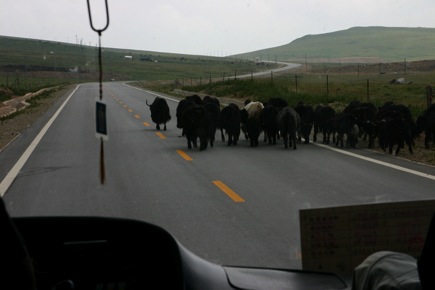

I admit, I dreaded some politically correct romanticizing minority-gazing, but visit was quite relaxed. The visit was negotiated by “Danny,” our guide, a cheerful fellow who seemed to supplement information with made-up stories.The nomads live in a fenced-in piece of land of their choice. They spread out a number of tents, the central tent being black, the so-called “yak tent.”
It should be mentioned that the nomads to have some modern equipment around (e.g. the herd the animals on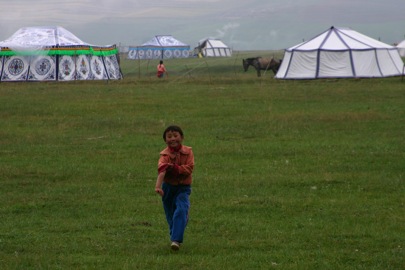 motorbikes instead of horses), and seem to live a simple, but by no means primitive life.
motorbikes instead of horses), and seem to live a simple, but by no means primitive life.
 motorbikes instead of horses), and seem to live a simple, but by no means primitive life.
motorbikes instead of horses), and seem to live a simple, but by no means primitive life. In the yak tent, a niche in the ground is covered with yak wool sheets. An iron oven in the middle warms up the place, wooden shelves contain cups and bowls. Bags of grain, tea, and yak dung stand around. A very cozy place. The oven is quite efficient in heating up the place (yak dung smells pleasant when burned, because the animals eat only grass), but two (optional) openings in the tent create a nice draft.
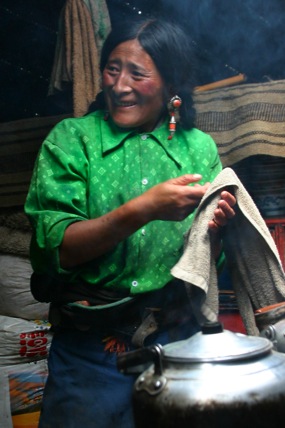 We exchange small talk about our families and grandchildren (if applicable). The nomad children are very interested in photos of Frans’s grandchildren. They have a great time watching those strange visitors with the long legs, digital cameras (they knew perfectly well that they can see themselves on the displays) and strange shoes. Also, my watch was met with utter fascination. The women make tea with yak milk and butter for us. We also sample the Tibetan standard “Tsampa,” a paste made of barley flour and milk and salt. It tastes like bread dough - very good bread dough.
We exchange small talk about our families and grandchildren (if applicable). The nomad children are very interested in photos of Frans’s grandchildren. They have a great time watching those strange visitors with the long legs, digital cameras (they knew perfectly well that they can see themselves on the displays) and strange shoes. Also, my watch was met with utter fascination. The women make tea with yak milk and butter for us. We also sample the Tibetan standard “Tsampa,” a paste made of barley flour and milk and salt. It tastes like bread dough - very good bread dough.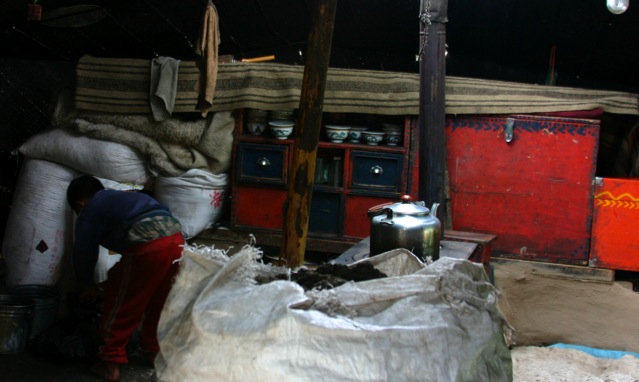
Langmusi
Mid-afternoon, we arrived in Langmusi, our highest destination yet (3300 m), where the first order of business was a visit to the monastery, which was, of course, uphill. This gave us a first taste of the altitude: Breathe in - breathe out - small steps. The monastery was quite beautiful, with stunning paintings of the “wrathful Buddha”. 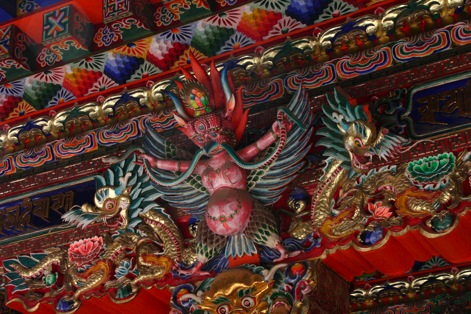 Unfortunately, many monks were on a holiday, so the place didn’t have the liveliness of Labrang.
Unfortunately, many monks were on a holiday, so the place didn’t have the liveliness of Labrang.
 Unfortunately, many monks were on a holiday, so the place didn’t have the liveliness of Labrang.
Unfortunately, many monks were on a holiday, so the place didn’t have the liveliness of Labrang.The real kicker was a visit to a “Sky Burial” place, which was still further uphill. Quite a bit further, as it turned out: After each turn a new upward stretch showed up.
Up up up we go, until we see a tent made of prayer flags next to a flat field filled with rubbish and hard to recognize body parts- the sky burial site.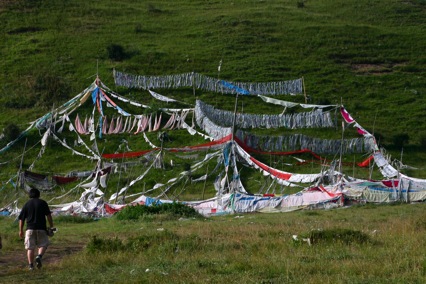

Sky burials a very common in Tibet, an alternative to the more expensive cremation. There are multiple stages to a sky burial. At first, the close family and best friends prepare the dead body and “say goodbye” to the dead in a private ceremony. Then, distant relatives and monks take the body to the burial site, which, as the name suggests, is always high up in the mountain. They cut up the body into small (hand sized) pieces. Sometimes, the body is only cut open in some places. The blood and smell attract vultures, who have to be kept in check with whips. Once the body is cut into pieces, the vultures are permitted to feed, leaving usually some bigger pieces, which are cut further and finally ground together with tsampa, and the vultures are allowed to feed again until the burial site is, ideally, empty.
It is hard to make up your mind on what to think about it. On the one hand, it fits a “circle of life” idea, and why would putting a body in the ground be better? On the other hand, it is a grisly ceremony, and very confrontational. The grisly ritual may well reflect the cruelty and finality of death more adequately than our glossy western rituals.
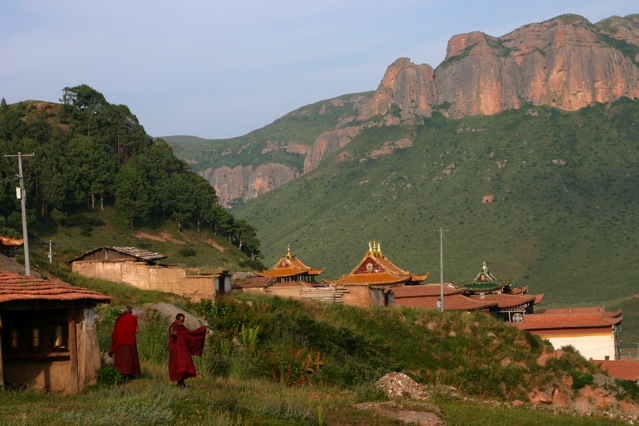
We dine at “Leysha’s Restaurant,” run by a muslim couple. The restaurant serves a melange of Chinese and “westernized” cuisine, all of it delicious, of course (it’s hard to find bad food in this country). 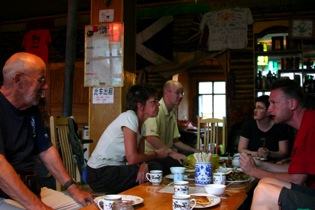 At Leysha’s, we order apple pie and chocolate pancakes for next day’s lunch on the road. We also have pancakes for breakfast next morning, with the exception of Erwin, who has a “Yak Burger.”
At Leysha’s, we order apple pie and chocolate pancakes for next day’s lunch on the road. We also have pancakes for breakfast next morning, with the exception of Erwin, who has a “Yak Burger.”
 At Leysha’s, we order apple pie and chocolate pancakes for next day’s lunch on the road. We also have pancakes for breakfast next morning, with the exception of Erwin, who has a “Yak Burger.”
At Leysha’s, we order apple pie and chocolate pancakes for next day’s lunch on the road. We also have pancakes for breakfast next morning, with the exception of Erwin, who has a “Yak Burger.”Overall, a glorious day!
And at the end of the day, exhaustion.


